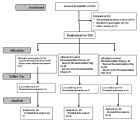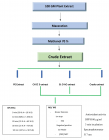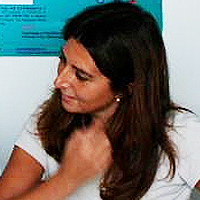Abstract
Review Article
Management and Therapeutic Strategies for Spinal Muscular Atrophy
Sheena P Kochumon and Cherupally Krishnan Krishnan Nair*
Published: 29 March, 2024 | Volume 7 - Issue 1 | Pages: 001-007
Spinal muscular atrophy is an autosomal recessive neuromuscular disorder characterized by progressive muscle weakness and atrophy. It is one of the most common single-gene disorders with an incidence rate of approximately 1 in 10,000 live births. The clinical manifestations are progressive hypotonia and muscle weakness due to the degeneration of alpha neurons in the anterior horn cells of the spinal cord and motor nuclei in the lower brain stem. Depending on the severity of the symptoms, SMA has five subtypes. Supportive measures can be offered for respiratory, gastrointestinal, and musculoskeletal complications. Carrier testing for all couples is recommended and this can be done by Multiplex Ligation-dependent Probe Amplification (MLPA). Prenatal diagnosis can be offered to carrier couples. Therapies must be given within the newborn period for maximum benefit and before the loss of motor neurons. It is achieved by identifying the SMA babies through Newborn screening. Several new FDA-approved drugs can reduce the progression of symptoms in SMA. However, they cannot offer a definite cure. Clinical follow-up and Neurological assessment demonstrate that SMA children can attain developmental milestones after receiving treatment, which is never normally attained in untreated cases. In utero SMA treatment with Zolgensma would enhance the survival rate and favorable neurological outcomes in the future. Base editing and Gene editing with CRISPR-Cas technologies to target the mutations and restore functional and stable SMN protein levels are the future hopes for a permanent cure of SMA.
Read Full Article HTML DOI: 10.29328/journal.jgmgt.1001009 Cite this Article Read Full Article PDF
Keywords:
Spinal Muscular Atrophy (SMA); Supportive care; Survival Motor Neuron (SMN) protein; SMN genes; Carrier analysis-MLPA; Genetic counseling; Prenatal diagnosis; Preimplantation Genetic Diagnosis (PGD); Newborn screening; Disease-Modifying Therapy (DMT); Fetal gene therapy; Gene editing-base editing and CRISPR-Cas
References
- Groen EJN, Talbot K, Gillingwater TH. Advances in therapy for spinal muscular atrophy: promises and challenges. Nat Rev Neurol. 2018 Apr;14(4):214-224. doi: 10.1038/nrneurol.2018.4. Epub 2018 Feb 9. PMID: 29422644.
- Phan HC, Taylor JL, Hannon H, Howell R. Newborn screening for spinal muscular atrophy: Anticipating an imminent need. Semin Perinatol. 2015 Apr;39(3):217-29. doi: 10.1053/j.semperi.2015.03.006. PMID: 25979781.
- Ogino S, Wilson RB. Genetic testing and risk assessment for spinal muscular atrophy (SMA). Hum Genet. 2002 Dec;111(6):477-500. doi: 10.1007/s00439-002-0828-x. Epub 2002 Oct 3. PMID: 12436240.
- Nilay M, Moirangthem A, Saxena D, Mandal K, Phadke SR. Carrier frequency of SMN1-related spinal muscular atrophy in north Indian population: The need for population based screening program. Am J Med Genet A. 2021 Jan;185(1):274-277. doi: 10.1002/ajmg.a.61918. Epub 2020 Oct 14. PMID: 33051992.
- Werdnig G. ZweifrühinfantilehereditäreFälle von progressiverMuskelatrophieunterdemBilde der Dystrophie, aberanfneurotischerGrundlage. Arch. FürPsychiatr. Nervenkrankh. 1891; 22: 437-480.
- Dubowitz V. Very severe spinal muscular atrophy (SMA type 0): an expanding clinical phenotype. Eur J Paediatr Neurol. 1999;3(2):49-51. doi: 10.1053/ejpn.1999.0181. PMID: 10700538.
- Clermont O, Burlet P, Lefebvre S, Bürglen L, Munnich A, Melki J. SMN gene deletions in adult-onset spinal muscular atrophy. Lancet. 1995 Dec 23-30;346(8991-8992):1712-3. doi: 10.1016/s0140-6736(95)92881-2. PMID: 8551862.
- Thomas NH, Dubowitz V. The natural history of type I (severe) spinal muscular atrophy. Neuromuscul Disord. 1994 Sep-Nov;4(5-6):497-502. doi: 10.1016/0960-8966(94)90090-6. PMID: 7881295.
- Arnold WD, Kassar D, Kissel JT. Spinal muscular atrophy: diagnosis and management in a new therapeutic era. Muscle Nerve. 2015 Feb;51(2):157-67. doi: 10.1002/mus.24497. Epub 2014 Dec 16. PMID: 25346245; PMCID: PMC4293319.
- Schroth MK. Special considerations in the respiratory management of spinal muscular atrophy. Pediatrics. 2009 May;123 Suppl 4:S245-9. doi: 10.1542/peds.2008-2952K. PMID: 19420154.
- Bach JR, Niranjan V, Weaver B. Spinal muscular atrophy type 1: A noninvasive respiratory management approach. Chest. 2000 Apr;117(4):1100-5. doi: 10.1378/chest.117.4.1100. PMID: 10767247.
- Nishio H, Niba ETE, Saito T, Okamoto K, Takeshima Y, Awano H. Spinal Muscular Atrophy: The Past, Present, and Future of Diagnosis and Treatment. Int J Mol Sci. 2023 Jul 26;24(15):11939. doi: 10.3390/ijms241511939. PMID: 37569314; PMCID: PMC10418635.
- Tangsrud SE, Carlsen KC, Lund-Petersen I, Carlsen KH. Lung function measurements in young children with spinal muscle atrophy; a cross sectional survey on the effect of position and bracing. Arch Dis Child. 2001 Jun;84(6):521-4. doi: 10.1136/adc.84.6.521. PMID: 11369575; PMCID: PMC1718814.
- Bernal S, Also-Rallo E, Martínez-Hernández R, Alías L, Rodríguez-Alvarez FJ, Millán JM, Hernández-Chico C, Baiget M, Tizzano EF. Plastin 3 expression in discordant spinal muscular atrophy (SMA) siblings. Neuromuscul Disord. 2011 Jun;21(6):413-9. doi: 10.1016/j.nmd.2011.03.009. Epub 2011 May 4. PMID: 21546251.
- Alías L, Barceló MJ, Bernal S, Martínez-Hernández R, Also-Rallo E, Vázquez C, Santana A, Millán JM, Baiget M, Tizzano EF. Improving detection and genetic counseling in carriers of spinal muscular atrophy with two copies of the SMN1 gene. Clin Genet. 2014 May;85(5):470-5. doi: 10.1111/cge.12222. Epub 2013 Jul 16. PMID: 23799925.
- Luo M, Liu L, Peter I, Zhu J, Scott SA, Zhao G, Eversley C, Kornreich R, Desnick RJ, Edelmann L. An Ashkenazi Jewish SMN1 haplotype specific to duplication alleles improves pan-ethnic carrier screening for spinal muscular atrophy. Genet Med. 2014 Feb;16(2):149-56. doi: 10.1038/gim.2013.84. Epub 2013 Jun 20. PMID: 23788250.
- Alías L, Bernal S, Calucho M, Martínez E, March F, Gallano P, Fuentes-Prior P, Abuli A, Serra-Juhe C, Tizzano EF. Utility of two SMN1 variants to improve spinal muscular atrophy carrier diagnosis and genetic counselling. Eur J Hum Genet. 2018 Oct;26(10):1554-1557. doi: 10.1038/s41431-018-0193-4. Epub 2018 Jun 14. PMID: 29904179; PMCID: PMC6138687.
- Jedrzejowska M, Borkowska J, Zimowski J, Kostera-Pruszczyk A, Milewski M, Jurek M, Sielska D, Kostyk E, Nyka W, Zaremba J, Hausmanowa-Petrusewicz I. Unaffected patients with a homozygous absence of the SMN1 gene. Eur J Hum Genet. 2008 Aug;16(8):930-4. doi: 10.1038/ejhg.2008.41. Epub 2008 Mar 12. PMID: 18337729.
- Lefebvre S, Bürglen L, Reboullet S, Clermont O, Burlet P, Viollet L, Benichou B, Cruaud C, Millasseau P, Zeviani M, et al. Identification and characterization of a spinal muscular atrophy-determining gene. Cell. 1995 Jan 13;80(1):155-65. doi: 10.1016/0092-8674(95)90460-3. PMID: 7813012.
- Lorson CL, Hahnen E, Androphy EJ, Wirth B. A single nucleotide in the SMN gene regulates splicing and is responsible for spinal muscular atrophy. Proc Natl Acad Sci U S A. 1999 May 25;96(11):6307-11. doi: 10.1073/pnas.96.11.6307. PMID: 10339583; PMCID: PMC26877.
- Monani UR, Lorson CL, Parsons DW, Prior TW, Androphy EJ, Burghes AH, McPherson JD. A single nucleotide difference that alters splicing patterns distinguishes the SMA gene SMN1 from the copy gene SMN2. Hum Mol Genet. 1999 Jul;8(7):1177-83. doi: 10.1093/hmg/8.7.1177. PMID: 10369862.
- Mailman MD, Heinz JW, Papp AC. Molecular analysis of spinal muscular atrophy and modification of the phenotype by SMN2. Genet Med 2002; 4:20.Darras BT. Non-5q spinal muscular atrophies: the alphanumeric soup thickens. Neurology. 2011; 77:312.
- Darras BT. Non-5q spinal muscular atrophies: the alphanumeric soup thickens. Neurology. 2011 Jul 26;77(4):312-4. doi: 10.1212/WNL.0b013e3182267bd8. Epub 2011 Jun 29. PMID: 21715708.
- Zerres K, Rudnik-Schöneborn S. 93rd ENMC international workshop: non-5q-spinal muscular atrophies (SMA) - clinical picture (6-8 April 2001, Naarden, The Netherlands). Neuromuscul Disord. 2003 Feb;13(2):179-83. doi: 10.1016/s0960-8966(02)00211-0. PMID: 12565918.
- Peeters K, Chamova T, Jordanova A. Clinical and genetic diversity of SMN1-negative proximal spinal muscular atrophies. Brain. 2014 Nov;137(Pt 11):2879-96. doi: 10.1093/brain/awu169. Epub 2014 Jun 25. PMID: 24970098; PMCID: PMC4208460.
- Wirth B, Karakaya M, Kye MJ, Mendoza-Ferreira N. Twenty-Five Years of Spinal Muscular Atrophy Research: From Phenotype to Genotype to Therapy, and What Comes Next. Annu Rev Genomics Hum Genet. 2020 Aug 31;21:231-261. doi: 10.1146/annurev-genom-102319-103602. Epub 2020 Jan 31. PMID: 32004094.
- Dubowitz V. Very severe spinal muscular atrophy (SMA type 0): an expanding clinical phenotype. Eur J Paediatr Neurol. 1999;3(2):49-51. doi: 10.1053/ejpn.1999.0181. PMID: 10700538.
- Lefebvre S, Bürglen L, Reboullet S, Clermont O, Burlet P, Viollet L, Benichou B, Cruaud C, Millasseau P, Zeviani M, et al. Identification and characterization of a spinal muscular atrophy-determining gene. Cell. 1995 Jan 13;80(1):155-65. doi: 10.1016/0092-8674(95)90460-3. PMID: 7813012.
- Bürglen L, Lefebvre S, Clermont O, Burlet P, Viollet L, Cruaud C, Munnich A, Melki J. Structure and organization of the human survival motor neurone (SMN) gene. Genomics. 1996 Mar 15;32(3):479-82. doi: 10.1006/geno.1996.0147. PMID: 8838816.
- McAndrew PE, Parsons DW, Simard LR, Rochette C, Ray PN, Mendell JR, Prior TW, Burghes AH. Identification of proximal spinal muscular atrophy carriers and patients by analysis of SMNT and SMNC gene copy number. Am J Hum Genet. 1997 Jun;60(6):1411-22. doi: 10.1086/515465. PMID: 9199562; PMCID: PMC1716150.
- Mailman MD, Heinz JW, Papp AC, Snyder PJ, Sedra MS, Wirth B, Burghes AH, Prior TW. Molecular analysis of spinal muscular atrophy and modification of the phenotype by SMN2. Genet Med. 2002 Jan-Feb;4(1):20-6. doi: 10.1097/00125817-200201000-00004. PMID: 11839954.
- Crawford TO, Paushkin SV, Kobayashi DT, Forrest SJ, Joyce CL, Finkel RS, Kaufmann P, Swoboda KJ, Tiziano D, Lomastro R, Li RH, Trachtenberg FL, Plasterer T, Chen KS; Pilot Study of Biomarkers for Spinal Muscular Atrophy Trial Group. Evaluation of SMN protein, transcript, and copy number in the biomarkers for spinal muscular atrophy (BforSMA) clinical study. PLoS One. 2012;7(4):e33572. doi: 10.1371/journal.pone.0033572. Epub 2012 Apr 27. PMID: 22558076; PMCID: PMC3338744.
- Wadman RI, Stam M, Gijzen M, Lemmink HH, Snoeck IN, Wijngaarde CA, Braun KP, Schoenmakers MA, van den Berg LH, Dooijes D, van der Pol WL. Association of motor milestones, SMN2 copy and outcome in spinal muscular atrophy types 0-4. J Neurol Neurosurg Psychiatry. 2017 Apr;88(4):365-367. doi: 10.1136/jnnp-2016-314292. Epub 2017 Jan 20. PMID: 28108522.
- Calucho M, Bernal S, Alías L, March F, Venceslá A, Rodríguez-Álvarez FJ, Aller E, Fernández RM, Borrego S, Millán JM, Hernández-Chico C, Cuscó I, Fuentes-Prior P, Tizzano EF. Correlation between SMA type and SMN2 copy number revisited: An analysis of 625 unrelated Spanish patients and a compilation of 2834 reported cases. Neuromuscul Disord. 2018 Mar;28(3):208-215. doi: 10.1016/j.nmd.2018.01.003. Epub 2018 Jan 11. PMID: 29433793.
- Prior TW, Swoboda KJ, Scott HD, Hejmanowski AQ. Homozygous SMN1 deletions in unaffected family members and modification of the phenotype by SMN2. Am J Med Genet A. 2004 Oct 15;130A(3):307-10. doi: 10.1002/ajmg.a.30251. PMID: 15378550; PMCID: PMC4349519.
- Monani UR, Coovert DD, Burghes AH. Animal models of spinal muscular atrophy. Hum Mol Genet. 2000 Oct;9(16):2451-7. doi: 10.1093/hmg/9.16.2451. PMID: 11005801.
- Prior TW, Krainer AR, Hua Y, Swoboda KJ, Snyder PC, Bridgeman SJ, Burghes AH, Kissel JT. A positive modifier of spinal muscular atrophy in the SMN2 gene. Am J Hum Genet. 2009 Sep;85(3):408-13. doi: 10.1016/j.ajhg.2009.08.002. Epub 2009 Aug 27. PMID: 19716110; PMCID: PMC2771537.
- Bernal S, Alías L, Barceló MJ, Also-Rallo E, Martínez-Hernández R, Gámez J, Guillén-Navarro E, Rosell J, Hernando I, Rodríguez-Alvarez FJ, Borrego S, Millán JM, Hernández-Chico C, Baiget M, Fuentes-Prior P, Tizzano EF. The c.859G>C variant in the SMN2 gene is associated with types II and III SMA and originates from a common ancestor. J Med Genet. 2010 Sep;47(9):640-2. doi: 10.1136/jmg.2010.079004. Epub 2010 Jun 24. PMID: 20577007.
- Yamamoto T, Sato H, Lai PS, Nurputra DK, Harahap NI, Morikawa S, Nishimura N, Kurashige T, Ohshita T, Nakajima H, Yamada H, Nishida Y, Toda S, Takanashi J, Takeuchi A, Tohyama Y, Kubo Y, Saito K, Takeshima Y, Matsuo M, Nishio H. Intragenic mutations in SMN1 may contribute more significantly to clinical severity than SMN2 copy numbers in some spinal muscular atrophy (SMA) patients. Brain Dev. 2014 Nov;36(10):914-20. doi: 10.1016/j.braindev.2013.11.009. Epub 2013 Dec 17. PMID: 24359787.
- Mendonça RH, Matsui C Jr, Polido GJ, Silva AMS, Kulikowski L, Torchio Dias A, Zanardo EA, Solla DJF, Gurgel-Giannetti J, de Moura ACML, Sampaio GPC, Oliveira ASB, de Souza PVS, Pinto WBVR, Gonçalves EA, Farias IB, Nardes F, Araújo APQC, Marques W Jr, Tomaselli PJ, Ribeiro MDO, Kitajima JP, Paoli Monteiro F, Saute JAM, Becker MM, Saraiva-Pereira ML, Brusius-Facchin AC, van der Linden V, Florêncio RN, Barbosa AVS, Machado-Costa MC, Pessoa ALS, Souza LS, Franca MC Jr, Kok F, Reed UC, Zanoteli E. Intragenic variants in the SMN1 gene determine the clinical phenotype in 5q spinal muscular atrophy. Neurol Genet. 2020 Sep 1;6(5):e505. doi: 10.1212/NXG.0000000000000505. PMID: 33062891; PMCID: PMC7524579.
- Wu X, Wang SH, Sun J, Krainer AR, Hua Y, Prior TW. A-44G transition in SMN2 intron 6 protects patients with spinal muscular atrophy. Hum Mol Genet. 2017 Jul 15;26(14):2768-2780. doi: 10.1093/hmg/ddx166. PMID: 28460014; PMCID: PMC5886194.
- Hofmann Y, Lorson CL, Stamm S, Androphy EJ, Wirth B. Htra2-beta 1 stimulates an exonic splicing enhancer and can restore full-length SMN expression to survival motor neuron 2 (SMN2). Proc Natl Acad Sci U S A. 2000 Aug 15;97(17):9618-23. doi: 10.1073/pnas.160181697. PMID: 10931943; PMCID: PMC16914.
- Oprea GE, Kröber S, McWhorter ML, Rossoll W, Müller S, Krawczak M, Bassell GJ, Beattie CE, Wirth B. Plastin 3 is a protective modifier of autosomal recessive spinal muscular atrophy. Science. 2008 Apr 25;320(5875):524-7. doi: 10.1126/science.1155085. PMID: 18440926; PMCID: PMC4908855.
- McGovern VL, Massoni-Laporte A, Wang X, Le TT, Le HT, Beattie CE, Rich MM, Burghes AH. Plastin 3 Expression Does Not Modify Spinal Muscular Atrophy Severity in the ∆7 SMA Mouse. PLoS One. 2015 Jul 2;10(7):e0132364. doi: 10.1371/journal.pone.0132364. PMID: 26134627; PMCID: PMC4489873.
- Riessland M, Kaczmarek A, Schneider S, Swoboda KJ, Löhr H, Bradler C, Grysko V, Dimitriadi M, Hosseinibarkooie S, Torres-Benito L, Peters M, Upadhyay A, Biglari N, Kröber S, Hölker I, Garbes L, Gilissen C, Hoischen A, Nürnberg G, Nürnberg P, Walter M, Rigo F, Bennett CF, Kye MJ, Hart AC, Hammerschmidt M, Kloppenburg P, Wirth B. Neurocalcin Delta Suppression Protects against Spinal Muscular Atrophy in Humans and across Species by Restoring Impaired Endocytosis. Am J Hum Genet. 2017 Feb 2;100(2):297-315. doi: 10.1016/j.ajhg.2017.01.005. Epub 2017 Jan 26. PMID: 28132687; PMCID: PMC5294679.
- Bernal S, Also-Rallo E, Martínez-Hernández R, Alías L, Rodríguez-Alvarez FJ, Millán JM, Hernández-Chico C, Baiget M, Tizzano EF. Plastin 3 expression in discordant spinal muscular atrophy (SMA) siblings. Neuromuscul Disord. 2011 Jun;21(6):413-9. doi: 10.1016/j.nmd.2011.03.009. Epub 2011 May 4. PMID: 21546251.
- Borry P, Evers-Kiebooms G, Cornel MC, Clarke A, Dierickx K. Public and Professional Policy Committee [PPPC] of the European Society of Human Genetics [ESHG]. Genetic testing in asymptomatic minors: background considerations towards ESHG Recommendations. Eur J Hum Genet. 2009; 17:711-9.
- Prior TW; Professional Practice and Guidelines Committee. Carrier screening for spinal muscular atrophy. Genet Med. 2008 Nov;10(11):840-2. doi: 10.1097/GIM.0b013e318188d069. PMID: 18941424; PMCID: PMC3110347.
- Prior TW. Spinal muscular atrophy: a time for screening. Curr Opin Pediatr. 2010 Dec;22(6):696-702. doi: 10.1097/MOP.0b013e32833f3046. PMID: 20829691.
- Committee Opinion No. 691: Carrier Screening for Genetic Conditions. Obstet Gynecol. 2017 Mar;129(3):e41-e55. doi: 10.1097/AOG.0000000000001952. PMID: 28225426.
- Prior TW; Professional Practice and Guidelines Committee. Carrier screening for spinal muscular atrophy. Genet Med. 2008 Nov;10(11):840-2. doi: 10.1097/GIM.0b013e318188d069. PMID: 18941424; PMCID: PMC3110347.
- Prior TW, Nagan N, Sugarman EA, Batish SD, Braastad C. Technical standards and guidelines for spinal muscular atrophy testing. Genet Med. 2011 Jul;13(7):686-94. doi: 10.1097/GIM.0b013e318220d523. PMID: 21673580.
- Hardy K, Handyside AH. Biopsy of cleavage stage human embryos and diagnosis of single gene defects by DNA amplification. Arch Pathol Lab Med. 1992 Apr;116(4):388-92. PMID: 1558477.
- Lee I, Alur-Gupta S, Gallop R, Dokras A. Utilization of preimplantation genetic testing for monogenic disorders. Fertil Steril. 2020 Oct;114(4):854-860. doi: 10.1016/j.fertnstert.2020.05.045. PMID: 33040985.
- Ramdas S, Servais L. New treatments in spinal muscular atrophy: an overview of currently available data. Expert Opin Pharmacother. 2020 Feb;21(3):307-315. doi: 10.1080/14656566.2019.1704732. PMID: 31973611.
- Mendell JR, Al-Zaidy S, Shell R, Arnold WD, Rodino-Klapac LR, Prior TW, Lowes L, Alfano L, Berry K, Church K, Kissel JT, Nagendran S, L'Italien J, Sproule DM, Wells C, Cardenas JA, Heitzer MD, Kaspar A, Corcoran S, Braun L, Likhite S, Miranda C, Meyer K, Foust KD, Burghes AHM, Kaspar BK. Single-Dose Gene-Replacement Therapy for Spinal Muscular Atrophy. N Engl J Med. 2017 Nov 2;377(18):1713-1722. doi: 10.1056/NEJMoa1706198. PMID: 29091557.
- Finkel RS, Mercuri E, Darras BT, Connolly AM, Kuntz NL, Kirschner J, Chiriboga CA, Saito K, Servais L, Tizzano E, Topaloglu H, Tulinius M, Montes J, Glanzman AM, Bishop K, Zhong ZJ, Gheuens S, Bennett CF, Schneider E, Farwell W, De Vivo DC; ENDEAR Study Group. Nusinersen versus Sham Control in Infantile-Onset Spinal Muscular Atrophy. N Engl J Med. 2017 Nov 2;377(18):1723-1732. doi: 10.1056/NEJMoa1702752. PMID: 29091570.
- Mercuri E, Darras BT, Chiriboga CA, Day JW, Campbell C, Connolly AM, Iannaccone ST, Kirschner J, Kuntz NL, Saito K, Shieh PB, Tulinius M, Mazzone ES, Montes J, Bishop KM, Yang Q, Foster R, Gheuens S, Bennett CF, Farwell W, Schneider E, De Vivo DC, Finkel RS; CHERISH Study Group. Nusinersen versus Sham Control in Later-Onset Spinal Muscular Atrophy. N Engl J Med. 2018 Feb 15;378(7):625-635. doi: 10.1056/NEJMoa1710504. PMID: 29443664.
- Haché M, Swoboda KJ, Sethna N, Farrow-Gillespie A, Khandji A, Xia S, Bishop KM. Intrathecal Injections in Children With Spinal Muscular Atrophy: Nusinersen Clinical Trial Experience. J Child Neurol. 2016 Jun;31(7):899-906. doi: 10.1177/0883073815627882. Epub 2016 Jan 27. PMID: 26823478; PMCID: PMC4871174.
- Seabrook T, Baranello G, Servais L. FIREFISH part 1: early clinical results following an increase of SMN protein in infants with type 1 spinal muscular atrophy (SMA) treated with risdiplam (RG7916). Paper presented at: MDA Clinical & Scientific Conference. 2019. Orlando.
- Baranello G, Servais L, Day J. FIREFISH part 1: 16-month safety and exploratory outcomes of risdiplam (RG7916) treatment in infants with type 1 spinal muscular atrophy. NeuromusculDisord. 2019; 29:S184; 353. doi:10.1016/j.nmd.2019.06.515.
- Chiriboga CA, Mercuri E, Fischer D. JEWELFISH: safety and pharmacodynamic data in patients with spinal muscular atrophy (SMA) receiving treatment with risdiplam (RG7916) that have previously been treated with nusinersen. NeuromusculDisord. 2019; 29:S187; 363. doi:10.1016/j.nmd.2019.06.525.
- De Vivo DC, Bertini E, Swoboda KJ, Hwu WL, Crawford TO, Finkel RS, Kirschner J, Kuntz NL, Parsons JA, Ryan MM, Butterfield RJ, Topaloglu H, Ben-Omran T, Sansone VA, Jong YJ, Shu F, Staropoli JF, Kerr D, Sandrock AW, Stebbins C, Petrillo M, Braley G, Johnson K, Foster R, Gheuens S, Bhan I, Reyna SP, Fradette S, Farwell W; NURTURE Study Group. Nusinersen initiated in infants during the presymptomatic stage of spinal muscular atrophy: Interim efficacy and safety results from the Phase 2 NURTURE study. Neuromuscul Disord. 2019 Nov;29(11):842-856. doi: 10.1016/j.nmd.2019.09.007. Epub 2019 Sep 12. PMID: 31704158; PMCID: PMC7127286.
- Ogbonmide T, Rathore R, Rangrej SB, Hutchinson S, Lewis M, Ojilere S, Carvalho V, Kelly I. Gene Therapy for Spinal Muscular Atrophy (SMA): A Review of Current Challenges and Safety Considerations for Onasemnogene Abeparvovec (Zolgensma). Cureus. 2023 Mar 15;15(3):e36197. doi: 10.7759/cureus.36197. PMID: 37065340; PMCID: PMC10104684.
- Atsumi A, Yoneda T, Tsuchida K, Kagawa Y, Tominaga S, Kawase K, Kikuchi N. [Pharmacological and clinical profile of Onasemnogene Aveparvovec, the first gene therapy for spinal muscular atrophy (SMA)]. Nihon Yakurigaku Zasshi. 2022;157(1):53-61. Japanese. doi: 10.1254/fpj.21066. PMID: 34980814.
- Chiriboga CA, Mercuri E, Fischer D, et al. P.363JEWELFISH: safety and pharmacodynamic data in patients with spinal muscular atrophy (SMA) receiving treatment with risdiplam (RG7916) that have previously been treated with nusinersen. NeuromusculDisord. 2019; 29:S187. doi:10.1016/j.nmd.2019.06.525.
- Bertini E, Day J, Muhaizea M, et al. P.362RAINBOWFISH: a study of risdiplam (RG7916) in newborns with pre-symptomatic spinal muscular atrophy (SMA). NeuromusculDisord. 2019; 29:S187. doi:10.1016/j.nmd.2019.06.524.
- Chen TH. New and Developing Therapies in Spinal Muscular Atrophy: From Genotype to Phenotype to Treatment and Where Do We Stand? Int J Mol Sci. 2020 May 7;21(9):3297. doi: 10.3390/ijms21093297. PMID: 32392694; PMCID: PMC7246502.
- Corti S, Nizzardo M, Nardini M, Donadoni C, Salani S, Ronchi D, Simone C, Falcone M, Papadimitriou D, Locatelli F, Mezzina N, Gianni F, Bresolin N, Comi GP. Embryonic stem cell-derived neural stem cells improve spinal muscular atrophy phenotype in mice. Brain. 2010 Feb;133(Pt 2):465-81. doi: 10.1093/brain/awp318. Epub 2009 Dec 23. PMID: 20032086.
- Alves CRR, Ha LL, Yaworski R, Sutton ER, Lazzarotto CR, Christie KA, Reilly A, Beauvais A, Doll RM, de la Cruz D, Maguire CA, Swoboda KJ, Tsai SQ, Kothary R, Kleinstiver BP. Optimization of base editors for the functional correction of SMN2 as a treatment for spinal muscular atrophy. Nat Biomed Eng. 2024 Feb;8(2):118-131. doi: 10.1038/s41551-023-01132-z. Epub 2023 Dec 6. PMID: 38057426; PMCID: PMC10922509.
Figures:
Similar Articles
-
Management and Therapeutic Strategies for Spinal Muscular AtrophySheena P Kochumon, Cherupally Krishnan Krishnan Nair*. Management and Therapeutic Strategies for Spinal Muscular Atrophy. . 2024 doi: 10.29328/journal.jgmgt.1001009; 7: 001-007
Recently Viewed
-
A Resurgence of the Idea of Hypertriglyceridemia and Lower Serum (HDL-C) as Predictive Factors for Insulin Resistance (IR) & Type 2 Diabetes Mellitus Development: A Narrative ReviewKulvinder Kochar Kaur*. A Resurgence of the Idea of Hypertriglyceridemia and Lower Serum (HDL-C) as Predictive Factors for Insulin Resistance (IR) & Type 2 Diabetes Mellitus Development: A Narrative Review. New Insights Obes Gene Beyond. 2025: doi: 10.29328/journal.niogb.1001022; 9: 001-012
-
Novel Mutation in Famous Gene Diseases in Red Blood CellsMahdi Nowroozi*. Novel Mutation in Famous Gene Diseases in Red Blood Cells. New Insights Obes Gene Beyond. 2025: doi: 10.29328/journal.niogb.1001023; 9: 013-020
-
Physical Performance in the Overweight/Obesity Children Evaluation and RehabilitationCristina Popescu, Mircea-Sebastian Șerbănescu, Gigi Calin*, Magdalena Rodica Trăistaru. Physical Performance in the Overweight/Obesity Children Evaluation and Rehabilitation. Ann Clin Endocrinol Metabol. 2024: doi: 10.29328/journal.acem.1001030; 8: 004-012
-
The Role of Genetic Mutations in the HPGD & SLCO2A1 Genes in Pachydermoperiostosis SyndromeShahin Asadi*,Arezo Zare,Sima Koohestani. The Role of Genetic Mutations in the HPGD & SLCO2A1 Genes in Pachydermoperiostosis Syndrome. J Genet Med Gene Ther. 2025: doi: 10.29328/journal.jgmgt.1001013; 8: 001-005
-
Estimation of Radiation Dose to Blood Vessels and Components from Medical Imaging Procedures: Current StatusKhalid M Aloufi*. Estimation of Radiation Dose to Blood Vessels and Components from Medical Imaging Procedures: Current Status. Arch Vas Med. 2025: doi: 10.29328/journal.avm.1001020; 9: 001-002
Most Viewed
-
Causal Link between Human Blood Metabolites and Asthma: An Investigation Using Mendelian RandomizationYong-Qing Zhu, Xiao-Yan Meng, Jing-Hua Yang*. Causal Link between Human Blood Metabolites and Asthma: An Investigation Using Mendelian Randomization. Arch Asthma Allergy Immunol. 2023 doi: 10.29328/journal.aaai.1001032; 7: 012-022
-
Impact of Latex Sensitization on Asthma and Rhinitis Progression: A Study at Abidjan-Cocody University Hospital - Côte d’Ivoire (Progression of Asthma and Rhinitis related to Latex Sensitization)Dasse Sery Romuald*, KL Siransy, N Koffi, RO Yeboah, EK Nguessan, HA Adou, VP Goran-Kouacou, AU Assi, JY Seri, S Moussa, D Oura, CL Memel, H Koya, E Atoukoula. Impact of Latex Sensitization on Asthma and Rhinitis Progression: A Study at Abidjan-Cocody University Hospital - Côte d’Ivoire (Progression of Asthma and Rhinitis related to Latex Sensitization). Arch Asthma Allergy Immunol. 2024 doi: 10.29328/journal.aaai.1001035; 8: 007-012
-
An algorithm to safely manage oral food challenge in an office-based setting for children with multiple food allergiesNathalie Cottel,Aïcha Dieme,Véronique Orcel,Yannick Chantran,Mélisande Bourgoin-Heck,Jocelyne Just. An algorithm to safely manage oral food challenge in an office-based setting for children with multiple food allergies. Arch Asthma Allergy Immunol. 2021 doi: 10.29328/journal.aaai.1001027; 5: 030-037
-
Snow white: an allergic girl?Oreste Vittore Brenna*. Snow white: an allergic girl?. Arch Asthma Allergy Immunol. 2022 doi: 10.29328/journal.aaai.1001029; 6: 001-002
-
Cytokine intoxication as a model of cell apoptosis and predict of schizophrenia - like affective disordersElena Viktorovna Drozdova*. Cytokine intoxication as a model of cell apoptosis and predict of schizophrenia - like affective disorders. Arch Asthma Allergy Immunol. 2021 doi: 10.29328/journal.aaai.1001028; 5: 038-040

If you are already a member of our network and need to keep track of any developments regarding a question you have already submitted, click "take me to my Query."



















































































































































